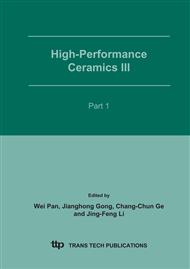[1]
S. Eiden-Assmann, J. Widoniak and G. Maret: Chem. Mater. Vol. 16 (2004), p.6.
Google Scholar
[2]
J.G. Yu, M. Lei, B. Cheng and X.J. Zhao: J. Solid State Chem. Vol. 177 (2004), p.681.
Google Scholar
[3]
B. Cheng, M. Lei, J.G. Yu and X.J. Zhao: Mater. Lett. Vol. 58 (2004), p.1565.
Google Scholar
[4]
J.G. Yu, M. Lei, B. Cheng and X.J. Zhao: J. Crystal Growth Vol. 261 (2004), p.566.
Google Scholar
[5]
M.R. Buchmeiser: J. Chromatogr. A Vol. 918 (2001), p.233.
Google Scholar
[6]
J. Kirkland, F. Truszkowski, C. Dilks and G. Engel: J. Chromatogr. Vol. A890 (2000), p.3.
Google Scholar
[7]
A. Dong, N. Ren, Y. Tang, Y. Wang, Y. Zhang, W. Hua and Z. Gao: J. Am. Chem. Soc. Vol. 125 (2003), p.4976.
Google Scholar
[8]
K.K. Unger: Packing and Stationary Phases in Chromatographic Techniques (Dekker, New York, 1990).
Google Scholar
[9]
I. Kimura, T. Kase, Y. Taguchi and M. Tanaka: Mater. Res. Bull. Vol. 38 (2003), p.585.
Google Scholar
[10]
U. Trudinger, G. Muller and K.K. Unger: J. Chromatogr. A Vol. 535 (1990), p.111.
Google Scholar
[11]
K. Tani and Y. Suzuki: Chromatographia Vol. 38 (1994), p.291.
Google Scholar
[12]
Y.R. Ma, L.M. Qi, J.M. Ma, Y.Q. Wu, O. Liu and H.M. Cheng: Coll. Surf. A Vol. 229 (2003), p.1.
Google Scholar
[13]
R.K. Iler and H.J. McQueston: U. S. Patent 4, 010, 242 (1997).
Google Scholar
[14]
R. Guo, J.G. Yu, L. Zhao and X.J. Zhao: Acta Chim. Sinica Vol. 62 (2004), p.493.
Google Scholar
[15]
B.D. Yao and L.D. Zhang: J. Mater. Sci. Vol. 34 (1999), p.5983.
Google Scholar
[16]
K.S.W. Sing, D.H. Everett, R.A.W. Haul, L. Moscou, R.A. Pierotti, J. Rouquerol and T. Siemieniewska: Pure Appl. Chem. Vol. 57 (1985), p.603.
DOI: 10.1002/9783527619474.ch11
Google Scholar
[17]
J.G. Yu, J.C. Yu, M.K.P. Leung, W.K. Ho, B. Cheng, X.J. Zhao and J.C. Zhao: J. Catal. Vol. 217 (2003), p.69.
Google Scholar
[18]
J.G. Yu, J.C. Yu, W.K. Ho and Z.T. Jiang: New J. Chem. Vol. 26 (2002), p.607.
Google Scholar
[19]
J.C. Yu, J.G. Yu and J.C. Zhao: Appl. Catal. B Vol. 36 (2002), p.31.
Google Scholar


